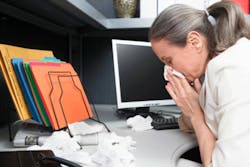Coughing, sniffling, sneezing and nose-blowing are common sounds of the workplace during the winter months. While most of us do our best to tolerate the sights and sounds of cold and flu season, some workplace behaviors are downright gross.
An online survey of U.S. adults revealed that 81 percent of Americans have witnessed a gross workplace habit, and the No. 1 answer is wiping a runny nose on hands or sleeves.
Based on the results of the Harris survey, commissioned by Cintas Corp., the top five “grossest” cold and flu behaviors include:
- Wiping runny nose on hands or sleeves – 16 percent
- Not covering mouth/nose when sneezing – 15 percent
- Not covering mouth when coughing – 12 percent
- Not washing hands frequently – 9 percent
- Leaving dirty tissues on desk – 8 percent
“While workplaces are full of poor hygiene habits, their frequency tends to increase around cold and flu season,” said Dave Mesko, senior director of marketing for Cintas. “To reduce the spread of viruses and bacteria, businesses need to increase cleaning frequencies and encourage employees to practice proper hand hygiene to keep them from getting sick in the first place.”
Survey respondents also cited a hacking cough, touching common-area surfaces while sick, persistent sniffling without blowing and nose-blowing in general as other gross cold and flu hygiene-related behaviors.
While respondents were given the opportunity to submit “other” gross behaviors, most of them focused on a lack of basic hand hygiene. A few of the other highlights include: “blowing nose into the sink,” “spitting in trash can or sink” and “the fact that they are there at all.”
To minimize the risk of getting sick this winter season, Cintas recommends the following hand-hygiene practices:
- Always use soap when washing hands and be sure to scrub for a minimum of 15 to 30 seconds to effectively remove germs.
- Use hand sanitizer in addition to – not in place of – hand-washing, as sanitizers are not as effective as soap and water at removing germs and bacteria.
- Always dry hands after washing, as germs and bacteria can be more easily transferred to and from wet hands
- Dry hands with paper towels instead of air dryers to help remove germs and bacteria, as air dryers can increase bacteria counts.
“Although hand hygiene is an important step in preventing the spread of infections and bacteria, facilities also need to plan for additional cleaning and disinfection during cold and flu season,” Mesko said. “Make sure your facility is ready with the proper cleaning tools, cleaning chemicals and techniques to ensure a healthy workplace.”
